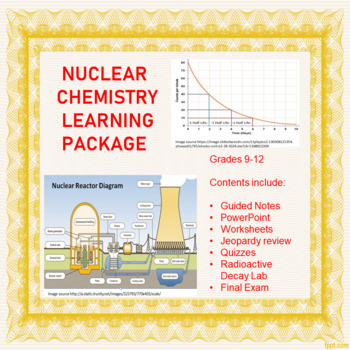Nuclear Chemistry Learning Package (Distance Learning)
- Zip
- Easel Assessment
Description
This zip file contains many different activities (44 pages of student handouts and 2 PowerPoints with a total of 93 slides) which can be used to compose a unit for chemistry students involving the basics on Nuclear Chemistry. Topics in this unit include fission, fusion, transmutation, types of radioactive decay, properties of alpha particles, beta particles and gamma rays, balancing nuclear equations, uses of some common radioisotopes, nuclear reactors and problems with the disposal of nuclear wastes. While these lessons were originally designed to correlate to the performance indicators of the New York State Chemistry - Physical Setting curriculum, the components of this lesson may be easily used in other chemistry or physical science courses as well. The components this unit addresses in the NGSS Standards and Common Core Standards are indicated at the end of this description.
The components of this lesson package can easily be displayed to students using and LCD projector and may be readily modified into formats facilitating smartboard technology.
Many documents are included in both word as well as pdf format to allow editing for specific teacher needs. These documents are well suited for use in distance learning environments.
The specific contents of the learning package includes the following items (the page count for these items are actual student handouts as answer key page counts are not included):
- Marzano self assessment scale including learning goals and Common Core Reading/Writing and Mathematics Standards for students specific to this unit (2 pp.)
- Scaffolded Completion Notes handout for students with learning goals and Common Core Standards to accompany lesson PowerPoint (14 pp.)
- 39 slide PowerPoint to accompany the Scaffolded Completion Notes
- Nuclear Chemistry Worksheet # 1 with answer key (5 pp./31 questions)
- Nuclear Chemistry Worksheet # 2 with answer key (6 pp./33 questions)
- Nuclear Chemistry Worksheet # 3 with answer key (3 pp./20 questions)
- Nuclear Chemistry Unit Exam with key (6 pp./33 multiple choice and written response questions)
- 25 question Jeopardy review game in PowerPoint format (54 slides)
- Reference Table for unit (2 pp.)
- Lab Activity (The Radioactive Decay of U-238 to Pb-206) with key (3 pp.)
- Nuclear Energy quiz # 1 with key (2 pp./11 questions)
- Learning Standards and Objectives (1 p.)
Bundle and Save!!
This learning package is part of the Complete High School Chemistry Course. Save time and money with the purchase of the Complete High School Chemistry Course! The complete course contains 12 Chemistry Units, as well as the Crash Course Chemistry Video Worksheet Guides. The Complete High School Chemistry Course is available for $27.99. This is a savings over 50% if each component in the Chemistry Complete Course was purchased individually. The units covered in the complete course can be viewed here.
Learning Goals
Upon the completion of this unit the student will be able to:
1. identify the natural changes in the nucleus.
2. explain what is meant by (transmutation), list and describe the 3 types of radiation
given off (alpha, beta, and gamma decay), and balance nuclear reactions involving these.
3. calculate the initial amount, the fraction remaining, or the half-life of a radioactive isotope, given 2 of the 3 variables.
4. explain where nuclear energy comes from (E=mc2) and explain binding energy.
5. discuss the two types of nuclear reactions (fission and fusion) and describe how both can be used for production of energy.
6. describe the problems associated with radioactive waste.
7. discuss some specific uses of radioisotopes such as tracers, radiation therapy and radioactive dating.
NGSS Standard
HS-PS1-8. Develop models to illustrate the changes in the composition of the nucleus of the atom and the energy released during the processes of fission, fusion, and radioactive decay.
Common Core State Standards Connections:
ELA/Literacy
RST.9-10.7 Translate quantitative or technical information expressed in words in a text into visual form (e.g., a table or chart) and translate information expressed visually or mathematically (e.g., in an equation) into words.
Mathematics
MP.4 Model with mathematics.
HSN-Q.A.1 Use units as a way to understand problems and to guide the solution of multi-step problems; choose and interpret units consistently in formulas; choose and interpret the scale and the origin in graphs and data displays.
HSN-Q.A.2 Define appropriate quantities for the purpose of descriptive modeling.
HSN-Q.A.3 Choose a level of accuracy appropriate to limitations on measurement when reporting quantities.
Terms of Use
Purchase of the product is for classroom use by the purchaser only. It is a violation for individuals, schools, and districts to redistribute or sell this item on the Internet or to other individuals. I do encourage you to use and edit these documents to suit your needs with your own students in distance learning environments.
This work is licensed under a Creative Commons Attribution-NonCommercial-ShareAlike 4.0 International License.






